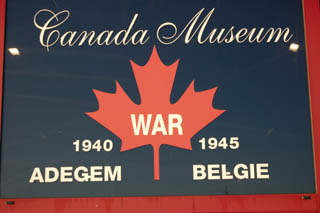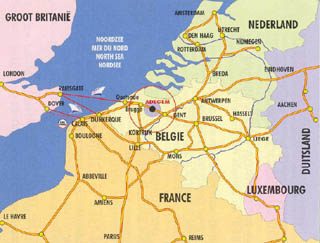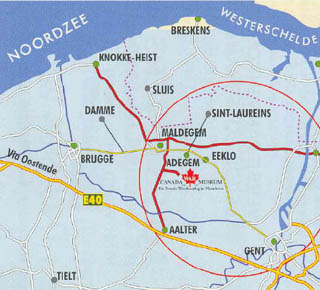Important note
Photos provided on this website are not an endorsement of any political idea or of war. War is one of the most regrettable human activities.
All
photos on this page are copyright Robert Mary and may only be reproduced
with my express permission. You may contact me here
Photos are not allowed inside this museum, I have been granted an exceptionnal
authorisation to make a limited number of photos.
The museum
![]()
The Canada museum
of Mr Gilbert Van Landschoot was opened on June 28th 1995..
It is not a state supported museum and it came into being as a result
of a death-bed promise he made to his father who died in 1987. The elder
Mr Van Landschoot was concerned that even after more than 40 years there
was so littel tribute to Canadians who liberated the Flemish people from
Nazi domination. On his death bed, the elder Mr Van Landschoot made a
confession and disclosed his role during the war: he told how he helped
people hiding from the Gestapo in cellars and tunnels and how he owed
his life to the Canadian liberators who had arrived just in time.
He made his son promise to
finally do something to tell the current generation about the misery
and the darkness of the war and about their liberation by the Canadians.
As a result of a meeting and a dialogue with the mayor of Adegem and
other prominent persons on the occasion of the 50th anniversary of
the Liberation, Mr Van Landschoot decided to erect the Canada museum,
thus following the family code of honor:"if one somebody helped you,
you have to do something in return". Building the canada museum became
his highest priority.

The museum was founded
in honour of all those who were affected by this
terrible period of history. We, the Belgian and Dutch people should
finally stand up and do show our gratitude to the Canadian people.
The official website
of the Canada Museum stands here.
Historical information:
Canada during WW2
19/08/1942: Operation Jubilee (landing on the French coast in
Dieppe) was the lowest point of the war for the Canadians. It was their
first
major
ground
action
of
WW2,
and
it
was a disaster. The Germans had advance warning when in the early hours
of Aug 19th, the eastern sector invasion force encountered a small German
convoy. The noise of the ensuing Naval battle alerted the coastal defences.
That, combined with an ill-conceived plan, doomed the operation before
it had even started. Although the operation was a failure, the lessons
learned about fire support, pre-invasion bombing and other tactics, helped
reduce the casualties of D-Day to an unexpected minimum...
10/07/1943:
The invasion of Sicily was the logical continuation of the North African
campaign, since capturing the island meant regaining almost complete
control over the Mediterranean. The Allies also had a secondary goal:
force Germany to pull land and air forces away from the Eastern front
in order to defend it's Southern side, thereby easing the pressure on
Russia. On July 4th and 5th, while enroute to Sicily, the Canadian assault
convoy was attacked by U-boats off the coast of Algeria, losing 3 supply
ships and over 500 vehicles, but none the less, Operation Husky was the
campaign in which the Canadians started to come together as an effective
fighting force...
6/12/1943:
As the first snow of winter began to fall, the Eighth Army struck hard
at the German line along the Sangro River on the Adriatic Coast. The
aim was to break the stalemate that had developed and to relieve the
pressure on the Fifth Army in the drive to take Rome. The task was not
easy for the Adriatic shoreline was cut by a series of deep river valleys.
As the British and Canadians succeeded in driving the Germans from the
Sangro, they were faced with the same task a few miles further north.
Here, along the line of the Moro River, occurred some of the bitterest
fighting of the war. The Germans counter-attacked repeatedly as the Canadians
edged forward to Ortona on the coast. At Ortona, during several days
of vicious street fighting, the Canadians smashed their way through walls
and buildings - "mouseholing" they called it. This was Christmas
1943. Meanwhile, a subsidiary attack had been launched to the northwest,
and the Germans, in danger of being cut off, withdrew from Ortona. The
city officially fell on December 28....
6/06/1944:
Operation Overlord, of which the landing at Juno Beach was a part, was
only one step of a global strategic plan for the complete defeat of Nazi
Germany. The Normandy landings were designed to establish bridgeheads
from which two armies, the First US Army on the west flank and the Second
British Army to the east could be supplied by sea. With the bridgeheads
firmly secured, the armies were to move on to liberate France and the
neighbouring countries. Germany, attacked on three separate fronts, in
Northwest Europe, in Russia, and in the Mediterranean, would soon be
exhausted and defeated. As D-Day drew to an end, the Canadians had managed
to advance quite deeply towards Creully, Colomby-sur-Thaon and Anisy,
short of their assigned target of Carpiquet Airfield, but far enough
to make the operation a definite success....
4/07/1944:
On July 4th, 1944, in preparation for the move on Caen, the Canadians
moved against the village of Carpiquet. Concealed in concrete pillboxes
and bunkers that defended the city, the Germans fired relentlessly at
the approaching Canadian troops. The city, and later, the airfield, were
finally captured after intense combat. Also In preparation for the assault
on Caen, the Allies had ordered massive air strikes. The Germans started
to fall back under the pressure. The city was liberated, but only in
part: the enemy still held the southern sector on the other side of the
Orne River. On July 18th, an air raid that dropped 7,700 tonnes of bombs,
synchronized with counter-battery fire from 33 artillery regiments, preceded
the crossing of the Orne River by the British and the Canadians....
11/07/1944:
During April and May 1944, the British Eighth Army, including the 1st
Canadian Corps, was secretly moved across Italy to join the Fifth U.S.
Army in the struggle for Rome. Here under the dominating peak of Cassino,
the Allied armies hurled themselves against the enemy position. Tanks
of the 1st Canadian Armoured Brigade (formerly 1st Canadian Army Tank
Brigade) supported the Allied attack. After four days of hard fighting,
the German defenses were broken from Cassino to the Tyrrhenian Sea and
the enemy moved back to his second line of defence. On May 18 Polish
troops took the Cassino position and the battered monastery at the summit.
Early on May 23 the attack on the Hitler Line went in. Under heavy enemy
mortar and machine-gun fire, the Canadians breached the defences and
the tanks of the 5th Armoured Division poured through toward the next
obstacle, the Melfa River. Desperate fighting took place in the forming
of a bridgehead across the Melfa. However, once the Canadians were over
the river, the major fighting for the Liri valley was over...
14/08/1944:
On August 14, the 2nd Canadian Infantry Division set out again to take
Falaise. It's ruins finally fell on August 17. Meanwhile, the 4th Canadian
and the 1st Polish Armoured Divisions hurried to block the German line
of retreat just east of the town. As American and Free French forces
sped from the south toward Argentan and Chambois, the 4th Canadian Armoured
occupied Trun from the north. While the division prepared a line of defence
along the Falaise-Trun-Chambois highway to bar the Germans from breaking
out of the pocket, most of the 1st Polish Armoured took up position further
east to head off the imminent enemy attempt to break in and extricate
their comrades. The rest of it drove on to Chambois and there joined
forces with American troops. The Falaise Gap was as good as closed at
last...
23/08/1944:
In the last week of August 1944, the entire Canadian Corps began its
attack on the Gothic Line with the objective of capturing Rimini. Six
rivers lay across the path of the advance. On August 25, the Canadians
crossed the Metauro River but the next, the Foglia was more formidable.
Here the Germans had concentrated their defences, and it required days
of bitter fighting and softening of the line by Allied air forces to
reach it. On August 30, the Canadians crossed the Foglia River and fought
their way to the Conca River, where the forward troops came under fire
from the German 1st Parachute Division, while to the west heavy fighting
was developing on the Coriano Ridge. By hard fighting the Canadians captured
the ridge and it appeared that the Gothic Line was finally about to collapse,
but this was not to be. For three more weeks the Canadians battled to
take the hill position of San Fortunato which blocked the approach to
the Po Valley. On September 21, the Allies entered a deserted Rimini.
The Canadian Corps was now withdrawn into Army reserve where they could
recuperate from the ten weeks of continuous fighting and train for the
battles which lay ahead. The Italian campaign continued into the spring
of 1945, but the Canadians did not participate in the final victory.
In February 1945 the 1st Canadian Corps was re-united with the First
Canadian Army in Northwest Europe. There they would join in the drive
into Germany and Holland...
22/10/1944: In early October 1944, the Allies controlled the harbours
north of the Seine but the supply issue was not yet solved: Dieppe, Le
Treport and Ostende had been opened but could not handle the high volumes
that Allied troops in Europe required. Le Havre, Boulogne and Calais
were not serviceable having suffered major destruction. Further north,
Antwerp had been liberated by the Allies on September 3rd, but the city
was located on the Schelde River, 80 kilometres from the open sea and
the river's mouth was still under German control. The only way to make
sure that the supplies required by the campaign in Europe could enter
the continent was to capture the Schelde...
8/02/1945: Operation Veritable, which began on 8 Feb 45, and later, Operation
Blockbuster, 25 Feb 45, were designed to overcome the three defensive
German lines built within the 30 km gap between the Maas and Rhine Rivers
east of Nijmegen. Also known as the Siegfried Lines, these German positions
consisted of trenches, anti-tank traps and wire belts which ran between
towns and farmhouses. Behind the lines was German territory, including
the cities of Cleve, Goch, Calcar, Geldern and Xanten. The plan was to
clear the area west of the Rhine river, then link up with American forces
pushing up from the south, (Operation Grenade 23 Feb 45). During this
month of fighting, the First Canadian Army lost 15,634 killed, wounded
or missing, including 5,304 Canadians, but they had gained the banks
of the Rhine which marked the last major line of German defence.
.2/04/1945: The Canadian Army's role in these final days of the war was to open up the supply route to the north through Arnhem, and then to clear the northeast and western Netherlands. Near Zutphen, Canadian soldiers liberated Stalag VI C, a camp for Russian POWs captured on the Eastern front. After occupying Zwolle, the Canadians then pressed on further north, but by then, the might of the Wehrmacht had been broken. Liberation Day, (Dutch: Bevrijdingsdag), is celebrated each year on May 5 in the Netherlands to mark the end of the German occupation during the Second World War. The nation was liberated largely by Canadian troops and to thank them each year, thousands of Tulip bulbs are sent to Ottawa where the annual May Tulip Festival is held.
Location information
The museum is located in the southern part of the town of Adegem, Belgium, not far from Brugge (between Gent and Brugge). The way to the museum is clearly sign-posted from the centre of Adegem.


Additional information
Tickets to gain
entry can be purchased at the bar in the tearoom. This is a private
venture
and
the building is also used for other activities,
most notably a dance school ("de Canadees"), seminars and
workshops, exhibition rooms, banquests and other festivities.
On the property, guided walks are daily arranged through three beautiful
gardens, each of them with the very specific style: the French romantic
garden with thousands of roses, the English land-scaped garden with waterfalls
and ponds, and the Japanese garden, symbol of human life.
Personal note
If you visit this museum, prefer summertime where gardens can be visited
in better conditions. Have a drink and/or a meal in the huge tearoom
too!